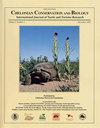Possible Effect of Global Climate Change on Caretta caretta (Testudines, Cheloniidae) Nesting Ecology at Guanahacabibes Peninsula, Cuba
IF 0.8
4区 生物学
Q3 ZOOLOGY
引用次数: 7
Abstract
Abstract Changing climate is affecting life all over the world. The loggerhead turtle (Caretta caretta) is one of the most vulnerable turtle species to climate change, particularly with regard to sex determination being affected by high temperatures in most nesting areas, such as the Cuban archipelago. As yet, species information is scarce for the Cuban archipelago as a whole. This study provides information about loggerheads in order to determine the possible effects of climate change on this species, especially in Guanahacabibes. We monitored 10 beaches along the southernmost coast of the Guanahacabibes Peninsula for 18 yrs (1998–2015), from May to September of each year, to determine nesting activity and density. Females were measured and tagged and the remigration interval was determined. Temporal variation was reflected in apparent peaks in reproductive activity on a biennial cycle. We found intraseasonal variation with the highest nesting activity in June, with a 15% increase in nesting activity in the second half of that month. Reduction in clutch size, incubation period, and hatchling size, as well as a potential feminization of hatchling production, indicates a possible effect of climate change in reproductive success. Our results are a first attempt at characterizing Guanahacabibes populations and have great value for establishing conservation priorities such as the protection of the nesting females and control of incubation environment in the face of global climate change within the context of national management plans.全球气候变化对古巴瓜纳哈卡比斯半岛Caretta carita(Testudines,Chelonidae)筑巢生态的可能影响
气候变化正在影响着全世界的生活。红海龟(Caretta Caretta)是最易受气候变化影响的海龟物种之一,特别是在大多数筑巢地区(如古巴群岛)的高温影响下,其性别决定。到目前为止,整个古巴群岛的物种信息很少。这项研究提供了关于红海龟的信息,以确定气候变化对这个物种的可能影响,特别是在瓜纳哈卡比斯。我们对瓜纳哈卡比斯半岛最南端海岸的10个海滩进行了18年(1998-2015)的监测,每年5月至9月,以确定筑巢活动和密度。对雌性进行测量和标记,并确定迁移间隔。时间变化反映在两年周期内生殖活动的明显高峰上。我们发现,6月份的筑巢活动最高,6月份下半月的筑巢活动增加了15%。卵群数量的减少、孵化期的缩短和幼雏数量的减少,以及幼雏数量的雌性化,都表明气候变化可能对繁殖成功产生影响。我们的研究结果是对瓜纳哈卡比斯种群特征的首次尝试,对于在全球气候变化的背景下在国家管理计划的背景下确定保护重点,如保护筑巢雌性和控制孵化环境具有重要价值。
本文章由计算机程序翻译,如有差异,请以英文原文为准。
求助全文
约1分钟内获得全文
求助全文
来源期刊
CiteScore
1.70
自引率
14.30%
发文量
17
审稿时长
>12 weeks
期刊介绍:
Chelonian Conservation and Biology is a biannual peer-reviewed journal of cosmopolitan and broad-based coverage of all aspects of conservation and biology of all chelonians, including freshwater turtles, marine turtles, and tortoises. Manuscripts may cover any aspects of turtle and tortoise research, with a preference for conservation or biology. Manuscripts dealing with conservation biology, systematic relationships, chelonian diversity, geographic distribution, natural history, ecology, reproduction, morphology and natural variation, population status, husbandry, community conservation initiatives, and human exploitation or conservation management issues are of special interest.

 求助内容:
求助内容: 应助结果提醒方式:
应助结果提醒方式:


